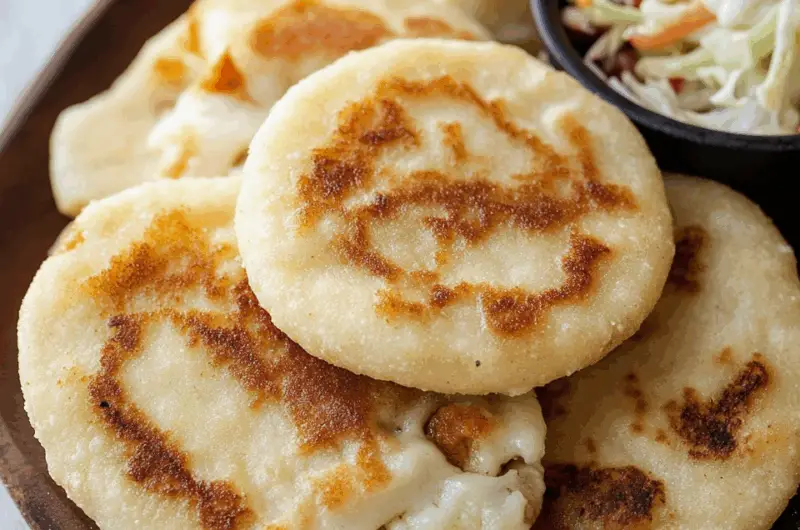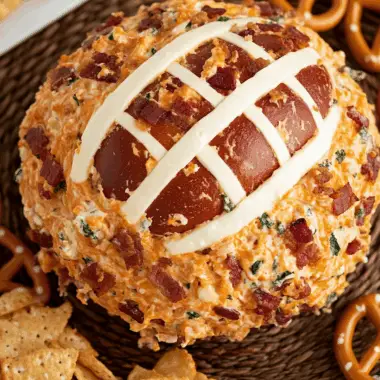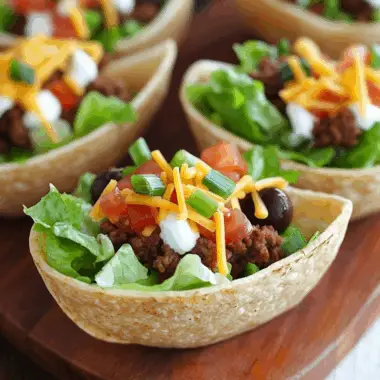The beauty of Salvadoran pupusas lies in their simplicity and the warmth they bring to the table. These stuffed masa cakes, traditionally filled with cheese, beans, or pork, are a staple in El Salvador and loved throughout Latin America. The crispy golden exterior contrasts with a soft, cheesy interior, making every bite a comforting and flavorful experience. When served with curtido a tangy cabbage slaw and a rich, homemade salsa roja, pupusas become more than just a meal; they become a celebration of culture and tradition. Whether enjoyed as street food or made fresh at home, they never fail to bring people together. Their naturally gluten-free base also makes them a fantastic alternative for those avoiding wheat, without compromising on flavor.
Full Recipe:
Ingredients:
-
2 cups masa harina
-
1 ½ cups warm water
-
1 cup shredded mozzarella or Oaxaca cheese
-
1 cup refried beans (black or pinto)
-
¼ tsp salt
-
Oil for greasing hands and skillet
Directions:
-
In a large mixing bowl, combine masa harina and salt. Gradually stir in the warm water until a dough forms. Let it rest for 5 minutes.
-
Divide the dough into 8 equal portions and roll them into balls.
-
Flatten a ball into a disk using your hands. Place about 1 tablespoon each of refried beans and cheese in the center.
-
Fold the dough around the filling, sealing it well, and then flatten into a thick disc about 4-5 inches wide.
-
Repeat the process for all pupusas.
-
Heat a lightly greased non-stick skillet or griddle over medium heat.
-
Cook each pupusa for about 3–4 minutes per side until golden brown spots appear and they’re slightly crispy on the outside.
-
Serve hot with curtido (pickled cabbage slaw) and salsa roja.
Prep Time: 15 minutes | Cooking Time: 20 minutes | Total Time: 35 minutes
Kcal: 210 kcal | Servings: 4 servings
Exploring the Delightful World of Pupusas: A Salvadoran Culinary Treasure
Pupusas, the national dish of El Salvador, offer an unforgettable blend of simplicity, comfort, and culture. At first glance, these handmade corn flour cakes may seem modest, but one bite reveals a rich culinary story filled with tradition and flavor. This dish represents the heart of Salvadoran home cooking and has become increasingly popular worldwide, especially among food lovers seeking comfort food with a cultural twist. The most popular variation, cheese and bean pupusas, is a crowd-pleasing, gluten-free delight that appeals to both seasoned foodies and curious home cooks.
In this article, we’ll dive deeper into the origin of pupusas, what makes them special, how they fit into modern dietary lifestyles, and why this humble dish deserves a spot on your dinner table. Whether you’re discovering pupusas for the first time or looking to master them at home, you’ll find everything you need to fall in love with this classic Latin American recipe.
A Glimpse Into the Origins of Pupusas
The origins of pupusas date back over 2,000 years to the indigenous Pipil tribes in what is now El Salvador. Originally prepared on clay griddles, pupusas were stuffed with edible flowers, herbs, and other locally available ingredients. Over time, the recipe evolved with the arrival of new cultures and ingredients, most notably beans, cheese, and pork.
Despite these changes, pupusas have always remained deeply tied to El Salvadoran identity. In fact, the dish was officially declared the national dish of El Salvador in 1985. Every second Sunday of November, Salvadorans celebrate “National Pupusa Day,” highlighting its importance in cultural celebrations, family gatherings, and national pride.
What Exactly Are Pupusas?
At their core, pupusas are thick corn tortillas made with masa harina (a special corn flour) and stuffed with a variety of fillings. The most common and beloved version is filled with refried beans and cheese, although other variations include meat (typically pork, known as chicharrón), vegetables, or loroco (a Salvadoran flower bud).
Once stuffed, the dough is sealed and shaped into a thick patty, then cooked on a hot griddle or skillet until the outside is golden and slightly crispy, while the inside remains soft and gooey. The result is a warm, handheld pocket of deliciousness that’s incredibly satisfying and versatile.
What elevates pupusas even further is the traditional pairing with curtido, a lightly fermented cabbage slaw that’s tangy and slightly spicy, and salsa roja, a simple tomato-based sauce. These sides balance the rich and cheesy filling, adding texture and brightness to every bite.
Pupusas in the Modern Kitchen
Although rooted in tradition, pupusas are incredibly adaptable and can fit seamlessly into a variety of modern eating habits. For example:
-
Gluten-Free Friendly: Pupusas are naturally gluten-free because they’re made with masa harina, making them an excellent alternative for people with celiac disease or gluten sensitivities.
-
Vegetarian-Friendly: The classic cheese and bean version is completely vegetarian, and easily modified to become vegan with plant-based cheese and oil-based refried beans.
-
Budget-Conscious: With just a few simple ingredients masa harina, water, beans, and cheese pupusas are an inexpensive and filling option for any household.
-
Kid-Friendly: Their handheld nature and mild flavors make them a great choice for picky eaters.
Home cooks can also explore new versions of pupusas by incorporating modern fillings such as sautéed mushrooms, spinach, sweet potato, jackfruit, or even scrambled tofu.
Cultural and Social Significance
Beyond their culinary appeal, pupusas hold significant social and cultural value. In El Salvador, they are often made during family gatherings or sold at pupuserías (pupusa stands), where recipes are passed down from generation to generation. Making pupusas is considered both a craft and a communal act. The tactile nature of shaping the dough, adding the filling, and flattening the disc creates a hands-on experience that connects people whether around the family kitchen or at a bustling street market.
Additionally, pupusas are making their way into food festivals, fusion cuisine, and global street food scenes. This rise in popularity helps keep Salvadoran culture alive and thriving in communities around the world, especially within Latin American diaspora neighborhoods in the United States, Canada, and Europe.
Tips for Perfecting Pupusas at Home
While the ingredient list is simple, there are some tricks to getting your pupusas just right:
-
Moist Dough: The dough should be soft and pliable, not dry or crumbly. It helps to let the masa rest for a few minutes after mixing.
-
Wet Hands: Keep a small bowl of water nearby to moisten your hands while shaping the pupusas. This prevents sticking and makes the process smoother.
-
Sealing Well: It’s crucial to fully enclose the filling to avoid leaks during cooking. Gently pressing and rotating the dough helps evenly distribute the stuffing without creating thin spots.
-
Medium Heat: Cook pupusas over medium heat to ensure they cook through without burning on the outside. Patience is key to getting that perfect golden crust.
Once you master the technique, you’ll find yourself making these again and again whether for lunch, dinner, or your next gathering.
Serving Suggestions and Pairings
Pupusas are delicious on their own, but when served with their traditional accompaniments, they shine even brighter.
Curtido is a lightly pickled cabbage slaw, typically made with vinegar, carrots, onions, and sometimes jalapeños. It brings a crunchy and acidic contrast that cuts through the richness of the cheese and beans.
Advertisement
Salsa Roja, a smooth tomato sauce made with garlic, onion, and spices, is often poured over or served alongside pupusas. Its bold and savory flavor complements the mild, cheesy filling.
To complete the meal, consider serving pupusas with:
-
A side of avocado or guacamole
-
A cup of Salvadoran horchata or tamarind juice
-
Fried plantains for a sweet and savory balance
Conclusion:
In a world full of fast food and instant meals, pupusas invite us to slow down and enjoy the beauty of handmade, humble cooking. They’re simple enough for beginners, customizable to any diet, and packed with flavor that tells a story. Whether you’re seeking a new cultural recipe to add to your weekly menu, or a fun cooking project for the family, cheese and bean pupusas are a fantastic place to start.








